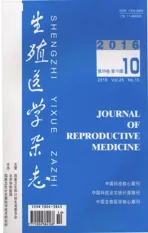卵巢低反应辅助治疗策略
2016-04-08龚斐李元
龚斐,李元
(1.中南大学基础医学院生殖与干细胞研究所,长沙 410078;2.中信湘雅生殖与遗传专科医院,长沙 410008)
卵巢低反应辅助治疗策略
龚斐1、2,李元2
(1.中南大学基础医学院生殖与干细胞研究所,长沙410078;2.中信湘雅生殖与遗传专科医院,长沙410008)
尽管经过二十余年的努力,对卵巢低反应研究颇多。但针对卵巢低反应患者,尚无明确有效的治疗方案改善卵巢反应和临床助孕结局;而一些辅助治疗策略为临床医生提高卵巢低反应者助孕结局提供了方向。本文就卵巢低反应的辅助治疗进行文献综述,包括脱氢表雄酮(DHEA),生长激素,黄体期添加雌激素,重组黄体生成素预处理等。
卵巢低反应;脱氢表雄酮;生长激素;雌激素;重组黄体生成素
(JReprodMed2016,25(10):901-903)
随着辅助生殖技术(Assisted Reproductive Technology,ART)的进步,目前国内外生殖中心IVF/ICSI助孕成功率稳步上升,为很多不孕家庭带来福音。但对于卵巢低反应(poor ovarian response,POR)这类特殊人群,如何改善助孕结局仍困扰着临床医生。卵巢低反应者的IVF/ICSI助孕特点[1-4]是:(1)低获卵数,有研究发现获卵1枚临床妊娠率约0~2.3%,获卵2枚临床妊娠率约4.3%~15.2%,获卵3~4枚则临床妊娠率在11.5%~15.9%之间波动;(2)高取消率5%~38%,由于无获卵、无可移植胚胎、胚胎质量差及子宫内膜容受性差等因素导致周期取消率居高不下;(3)低临床妊娠率,有相关研究发现卵巢低反应者以年龄分界:年龄>36岁者临床妊娠率1.5%~12.7%,而年龄≤36岁者则临床妊娠约3%~35%。但是综合以上可以发现,卵巢低反应者的低获卵数、下降的卵母细胞质量是明显降低ART助孕结局的始动因素。而临床处理中主要通过调整助孕方案及积极辅助治疗等干预措施而改善卵巢低反应者助孕结局。以下就2016 年综述中提及的至少一项随机对照研究(Randomized controlled study,RCT)提示对卵巢低反应者有改善作用的辅助治疗进行概述,如脱氢表雄酮(dihydroepiandrosterone,DHEA)、生长激素(Growth hormone,GH)、黄体期添加雌激素(Estrogen,E2)及重组黄体生成素(recombinant luteinizing hormone,rLH)预处理等[5]。
一、DHEA
雄激素在卵泡微环境的适量积聚,可促进颗粒细胞的增殖,增加窦前和窦卵泡的数量,刺激早期卵泡的生长。在POR 患者中增加卵泡微环境雄激素浓度的治疗可能增加IVF患者卵巢刺激的卵泡数和成熟度,这些治疗包括 DHEA、睾酮经皮给药[6]。DHEA是由肾上腺皮质的网状带(85%)和卵巢卵泡膜细胞(15%)产生的内源性类固醇;在卵巢,促进卵泡发育、颗粒细胞增殖,且增加卵巢内雄激素浓度;DHEA增加卵泡内胰岛素样生长因子-1(Insulin-like growth factor-1,IGF-1)水平而增加卵泡对促性腺激素(Gonadotropin,Gn)的反应且减少卵泡闭锁[7]。早期的研究显示[8],DHEA可改善POR 者 ART 过程中卵巢的反应性,改善胚胎质量,降低流产率,增加妊娠率。目前全世界超过1/4的IVF 中心对 POR 患者使用 DHEA。2016年一篇meta分析认为[8]:DHEA明显改善POR临床妊娠率、活产率、及着床率;且明显增加POR回收卵数和抗苗勒管激素(AMH)水平等。最近一篇综述发现[9]:4个回顾性分析提示DHEA有助于改善累计妊娠率,降低流产率,减少非整倍体胚胎;7个自身对照研究发现DHEA有助于改善获卵数、优胚数、卵巢储备评估指标等;6个RCT研究提示DHEA有助于增加窦卵泡数(AFC)、改善胚胎质量及提高活产率等。2015年一篇meta分析则推荐促排前6~24周使用DHEA 25 mg 3次/d(或75~90 mg/d)[10]。Yeung等[11]的一篇RCT文章认为:DHEA制剂的添加虽能增加血清和卵泡液的DHEA水平,但并不能增加获卵数、不能改善卵巢储备评估指标 (AFC,AMH,或 FSH),且对IVF助孕结局无明显改善作用。尽管对DHEA的研究颇多,但是,DHEA在ART中的助孕疗效仍然有争议;虽然诸多meta分析结果不一致,但meta分析研究本身存在局限性:(1)卵巢低反应或卵巢低储备定义不统一;(2)入选研究设计不统一(RCT/自身对照/回顾性分析);(3)DHEA药物使用时间及剂量不统一。DHEA服用≥6周才有效果,因有适应证及禁忌证,请由临床医生酌情使用。
二、生长激素(GH)
早在1972年GH用于人类生殖。GH作为旁分泌激素在卵巢甾体激素合成和卵泡发育中起重要作用。添加 GH 协同 Gn 可增加颗粒细胞上的 LH 受体水平和刺激卵巢芳香化酶的活性,从而改善卵巢对Gn的反应性,促进患者卵泡的募集,并且增加子宫内膜容受性,有利于胚胎着床[6]。研究显示[12]:Gn可能有助于改善子宫内膜,提高临床妊娠率和活产率。也有研究认为[13],GH增加了获卵数和双原核(2PN)数,提高了卵巢反应性,但对妊娠结局无改善。2016年一篇RCT研究在POR者拮抗剂方案中从Gn第6天开始使用GH 2.5 mgSC(7.5 IU/d)(Norditropin,Novo Nordisk)至HCG日,与对照组相比,GH组回收卵数、MⅡ卵数、受精卵数等明显增加[14]。早期曾有在促排的同时添加GH至扳机(trigger)日。目前关注在窦前卵泡阶段使用GH,具体用法用量均无统一标准,且GH在全世界范围内未广泛应用,因此仍需RCT大样本研究。
三、黄体期添加雌激素(E2)
卵巢低反应者由于卵巢储备少,颗粒细胞少,因而雌激素较正常反应者不足;低水平E2降低子宫内膜容受性及IVF助孕结局。既往研究提示:黄体支持添加雌激素能纠正57%的子宫内膜不同步,有助于改善低反应者助孕结局[15-16]。2014年RCT分析示:黄体期添加2 mg E2明显增加POR生化妊娠、临床妊娠率及活产率[17]。理论上,对于卵巢低反应患者黄体支持添加雌激素是有助于改善子宫内膜与胚胎发育同步性,但既往研究结论仍是不明确的:两篇系统性分析均认为黄体期添加雌激素并不能改善IVF助孕结局[18-19]。因此,该辅助治疗仍需更多数据研究证实。
四、rLH预处理
卵巢低反应者往往伴有卵巢高龄化(aging ovaries),而随着年龄增加,卵巢LH受体逐渐减少。研究认为[20-21]:FSH刺激前使小卵泡暴露于LH环境状态下,增加胞质成熟度,进而促进胚胎同步性发育,因此rLH预处理方案在临床上进行了研究。2014年一篇RCT研究对POR者在短方案促排前4 d给予rLH (150 IU/d)后开始重组FSH(rFSH)后发现rLH组获卵数、活产率明显增加,着床率有上升趋势,后续增加样本量进行回顾性分析发现rLH组明显降低取消率、增加卵裂率、着床率、临床妊娠率及活产率[21]。
尽管经历近20余年的尝试,但对于卵巢低反应者仍无统一有效的辅助治疗方案。目前,没有哪一种方案绝对优于另一种方案,因为无论是meta分析还是系统性评价均显示支持的证据尚不充分。对于卵巢低反应者,应该设计更大样本更严密更规范(如卵巢低反应标准)的RCT研究进行助孕策略分析,方案定制个体化,期待更有效的临床管理策略。
[1]Ulug U,Ben-Shlomo I,Turan E,et al.Conception rates following assisted reproduction in poor responder patients:a retrospective study in 300 consecutive cycles[J/OL].Reprod Biomed Online, 2003,6:439-443.
[2]Frattarelli JL,Hill MJ,McWilliams GD,et al.A luteal estradiol protocol for expected poor-responders improves embryo number and quality[J].Fertil Steril,2008,89:1118-1122.
[3]Oudendijk JF,Yarde F,Eijkemans MJ,et al.The poor responder in IVF:is the prognosis always poor?:a systematic review[J].Hum Reprod Update,2012,18:1-11.
[4]Timeva T,Milachich T,Antonova I,et al.Correlation between number of retrieved oocytes and pregnancy rate after in vitro fertilization/intracytoplasmic sperm infection[J].ScientificWorldJournal,2006,6:686-690.
[5]Papathanasiou A,Searle BJ,King NM,et al.Trends in ‘poor responder’ research:lessons learned from RCTs in assisted conception[J].Hum Reprod Update,2016,33:981-991.
[6]武学清,孔蕊,田莉,等.卵巢低反应专家共识[J]. 生殖与避孕,2015,35:13.
[7]Zhang M,Niu W,Wang Y,et al.Dehydroepiandrosterone treatment in women with poor ovarian response undergoing IVF or ICSI:a systematic review and meta-analysis[J].J Assist Reprod Genet,2016,33:981-991.
[8]Sönmezer M,Ozmen B,Cil AP,et al.Dehydroepiandrosterone supplementation improves ovarian response and cycle outcome in poor responders[J/OL].Reprod Biomed Online,2009,19:508-513.
[9]Lin LT,Tsui KH,Wang PH,et al.Clinical application of dehydroepiandrosterone in reproduction:A review of the evidence[J].J Chin Med Assoc,2015,78:446-453.
[10]Li J,Yuan H,Chen Y,et al. A meta-analysis of dehydroepiandrosterone supplementation among women with diminished ovarian reserveundergoing in vitro fertilization or intracytoplasmic sperm injection[J].Int J Gynaecol Obstet,2015,131:240-245.
[11]Yeung TW,Chai J,Li RH,et al.A randomized,controlled,pilot trial on the effect of dehydroepiandrosterone on ovarian response markers,ovarian response,and in vitro fertilization outcomes in poor responders[J].Fertil Steril,2014,102(1):108-115.e1
[12]Kolibianakis EM,Venetis CA,Diedrich K,et al.Addition of growth hormone to gonadotrophins in ovarian stimulation of poor responders treated by in-vitro fertilization:a systematic review and meta-analysis[J].Hum Reprod Update,2009,15:613-622.
[13]Eftekhar M,Aflatoonian A,Mohammadian F,et al.Adjuvant growth hormone therapy in antagonist protocol in poor responders undergoing assisted reproductive technology[J].Arch Gynecol Obstet,2013,287:1017-1021.
[14]Bassiouny YA,Dakhly DM,Bayoumi YA,et al.Does the addition of growth hormone to the in vitro fertilization/intracytoplasmic sperm injection antagonist protocol improve outcomes in poor responders? A randomized,controlled trial[J].Fertil Steril,2016,105:697-702.
[15]Ferraretti AP,La Marca A,Fauser BC,et al.ESHRE consensus on the definition of ‘poor response’ to ovarian stimulation for in vitro fertilization:the Bologna criteria[J].Hum Reprod,2011,26:1616-1624.
[16]Chang EM,Han JE,Won HJ,et al.Effect of estrogen priming through luteal phase and stimulation phase in poor responders in in-vitro fertilization[J]. J Assist Reprod Genet,2012,29:225-230.
[17]Kutlusoy F,Guler I,Erdem M,et al. Luteal phase support with estrogen in addition to progesterone increases pregnancy rates in in vitro fertilization cycles with poor response to gonadotropins[J].Gynecol Endocrinol,2014,30:363-366.
[18]van der Linden M,Buckingham K,Farquhar C,et al.Luteal phase support for assisted reproduction cycles.Cochrane[DB] Database Syst Rev,2011,Oct 5;(10):CD009154.
[19]Jee BC,Suh CS,Kim SH,et al.Effects of estradiol supplementation during the luteal phase of in vitro fertilization cycles:a meta-analysis[J].Fertil Steril,2010,93:428-436.
[20]Musters AM,van Wely M,Mastenbroek S,et al.The effect of recombinant LH on embryo quality:a randomized controlled trial in women with poor ovarian reserve[J].Hum Reprod,2012,27:244-250.
[21]Ferraretti AP,Gianaroli L,Motrenko T,et al.LH pretreatment as a novel strategy for poor responders[J].Biomed Res Int,2014;2014:926172. doi:1155/2014/926172
[编辑:谷炤]
Adjuvant treatment strategy for poor ovarian response
GONG Fei1,2,LI Yuan2
1.InstituteofReproductive&StemCellEngineering,CentralSouthUniversity,Changsha410078 2.Reproductive&GeneticHospitalofCITIC-XIANGYA,Changsha410008
Despite the fact that an enormous number of papers on the topic of poor ovarian response (POR) have been published in the last two decades,so far it is still impossible to identify any efficient treatment to improve the ovarian response and the clinical outcome for these patients. Currently,some intervention is accepted as beneficial in overcoming poor ovarian response. Basing on published meta-analyses and papers,various additional alternatives,such as DHEA,growth hormone,luteal support with estrogen,pretreatment of recombinant LH (rLH),are summarized in this review.
Poor ovarian response;DHEA;Growth hormone;Estradiol;Recombinant LH
10.3969/j.issn.1004-3845.2016.10.008
2016-06-26;【收回日期】2016-08-01
龚斐,女,广西南宁人,副主任医师,生殖医学专业.
